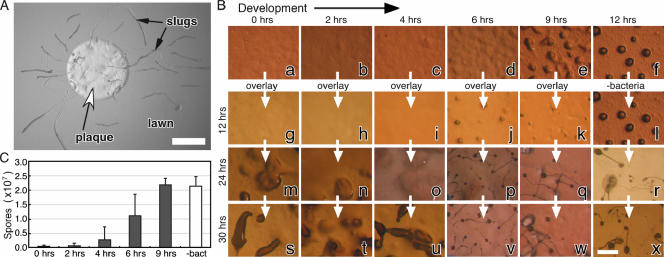FIG. 1.
Commitment after 4 h of development. (A) Dictyostelium slugs migrate across a bacterial lawn, illustrating that developing amoebae are insensitive to nutrients. The lighter circle in the center of the bacterial lawn is a plaque (white arrowhead) caused by Dictyostelium cells that have consumed the bacteria. The elongated rods emanating from the plaques are slugs (black arrows). Scale bar, 2 mm. (B) Dictyostelium cells were starved on nonnutrient agar plates (time zero) and morphology was recorded for the times indicated above the pictures (panels a to f). Bacteria were added (overlay) to duplicate plates at the times indicated above the pictures, and morphology was recorded after 12 h (panels g to k), 24 h (panels m to q), and 30 h (panels s to w). Controls without added bacteria were photographed at the same times (panels l, r, and x, respectively). All of the time points are relative to the initiation of starvation (time zero). White arrows indicate that photographs of the same plate were taken at different times. Some of the pictures represent the same field over time. Scale bar, 1 mm. (C) Cells (1 × 107) were developed as described above, and spores were collected and counted after 30 h from the time of initial starvation. The sporulation levels of cultures overlaid with bacteria at the indicated times (0, 2, 4, 6, and 9 h) are represented by dark bars, and the sporulation of the untreated culture (−bact) is represented by a white bar. Data are averages ± standard deviations (SD) of four independent replications.

